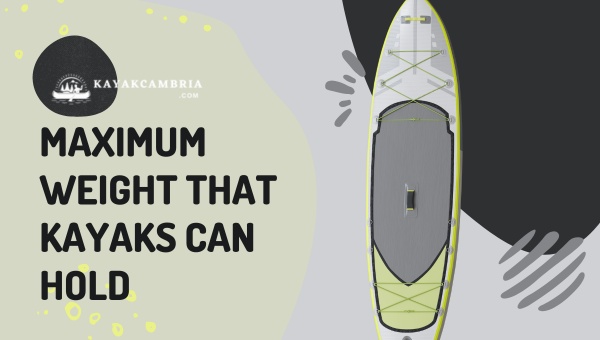When it comes to kayaks, weight is a very important factor. It affects how much you can carry and how easy it is to transport. The weight of a kayak depends on the material and features it has. No matter what type of kayak you choose, it is important to factor in the weight as this will determine how easy it is to use and transport.
In this blog post, we will discuss the topic “How much does a kayak weigh?”. We will go through the different materials used for Kayaks, features, and other components that contribute to the weight of a Kayak.
Contents
Contents
Are Kayaks Heavy Or Light?

Every kayak is different. The weight of a kayak is also different depending on the model you choose and what type of material it is made from. Kayaks can be heavy or lightweight as it is completely up to the material used in construction.
There are many models of kayaks available in the market, each with its own weight and features. So before you buy a kayak, be sure to check its weight of it to ensure that you can carry and transport it easily.
What Factors Influence The Weight Of A Kayak?

There are a few factors that impact the weight of a kayak. We will discuss them in detail below.
1. Use Of Kayak

Different paddlers use kayaks for different activities and different types of kayaks fit each activity. Some paddlers want to paddle to enjoy free time, some want to pedal quietly to their favorite spot and some want to do kayaking as a professional. So each activity needs a different style of the kayak which affects the weight of the kayak.
2. Kayak Forms

Different types of kayak forms affect the weight of the kayak. Below are the kayak forms:-
- Recreational Kayaks: These are designed for all-around use on rivers, lakes, and oceans and are not tuned for speed or high performance. They capture broad, typical kayak use.
- Inflatable Kayaks: These are used for low-intensity or high-intensity endeavors. They have unique construction and characteristics.
- Fishing kayaks: These are designed for fishing, usually with sit-on-top designs. They come in many different shapes and sizes and the aim is to get the angler to the fish with ease. Some of them may be outfitted with additional accessories such as pedals and fish-finding equipment which adds more weight to the kayak.
- Sea kayaks: These are designed for oceanic voyages and coastal regions and long-distance travel. They are usually long and lean, giving up stability which makes them fast but more difficult to control.
- River kayaks: Designed for rivers and creeks, they are short, durable, and can turn on a dime. These are best suited to Class I-III rapids depending on the model chosen.
3. Construction Of Kayak

The construction of the kayak directly affects its weight. Kayaks are generally constructed with various materials such as plastic, wood, and aluminum.
- Plastic (Polyethylene): Recreational kayaks are constructed from roto-molded polyethylene which is durable and affordable. Kayaks made from HDPE are heavy.
- Thermoformed plastic: Thermoformed plastic is the more expensive manufacturing process and is lighter than HDPE. It is also durable and easy to repair.
- Fiberglass or Carbon Fiber: Kayaks made of fiberglass or carbon fiber are constructed by applying sheets of fiberglass or carbon fiber onto a rigid frame. These types of kayaks are typically longer and lighter than plastic kayaks and are designed for performance rather than durability.
- Vinyl: The least expensive inflatable kayaks are constructed from a single layer of thin vinyl. These are lightweight and great for recreational use.
- PVC: The more expensive inflatable kayaks are constructed from PVC. They are lightweight and offer great performance in the water.
How Much Does A Kayak Weigh?

Weigh is something that varies greatly from kayak to kayak depending on the type and size of the model. Generally, kayaks will weigh between 20 and 80 pounds. This range is influenced by the material used in construction, the size and model of the kayak, as well as any accessories that may be installed on it.
Average Weight Of Different Types Of Kayak

In this section, we will discuss the average weight of different types of kayaks.
1. Recreational Kayak

This type of kayak is designed with a large cockpit, so paddlers can easily get in and off them. They are usually 24 inches wide and 12 feet long. The average weight of recreational kayaks depends on the material used for constructing them. Recreational kayaks made from polyethylene plastic are durable and stable and typically weigh around 30-50 pounds.
2. Inflatable Kayak

This type of kayak is easy to carry, store and use. The average weight of an inflatable kayak depends on the size and material used in construction. Generally, they weigh anywhere from 20-50 pounds, with the common ones weighing around 30 pounds.
3. Fishing Kayak

Fishing kayaks are designed for fishing, usually with sit-on-top designs. The average weight of a fishing kayak depends on the materials used in constructing it. Fishing kayaks are typically heavier than recreational kayaks and usually have additional accessories like fishing gear, tackle boxes, storage boxes, and the like added to their weight. In most cases, they weigh above 100 pounds but some may weigh as little as 35 pounds.
4. Sea Kayak

Sea kayaks are designed for experienced paddlers and sports enthusiasts. They are typically longer and slimmer than recreational kayaks, allowing them to handle heavy currents, wind, and waves. Sea kayaks usually weigh around 40-60 pounds depending on how much equipment you bring on board. It is a great choice if you are looking for long-distance and multi-day voyages.
5. Tandem Kayak

Tandem kayaks are designed for two paddlers. They come with two cockpits and are usually longer than single-person kayaks. Tandem kayaks are typically twice as heavy as recreational kayaks and can weigh between 50-75 pounds. However, depending on the materials used in construction and the accessories that some of them include, they may weigh as much as 100 pounds. The length of any kayak plays a significant role in how much it can weigh.
6. Whitewater Kayak

Whitewater kayaks are made from roto-molded polyethylene which is durable and tough enough to withstand the impacts of whitewater rapids. Although these kayaks are heavier than fiberglass ones, they range anywhere between 40-60 pounds depending on the model chosen.
Does Kayak Length Affect Its Weight?

The answer to this question is yes. A kayak’s length will have a direct impact on its weight. Generally, the longer your kayak is, the more it will weigh. However, shorter doesn’t always mean lighter as different materials may affect the total weight of the kayak even if it has the same length.
Longer kayaks usually weigh more than shorter ones but offer you advantages like better tracking and gliding in water with greater control. They are also great for beginners as they provide better stability on the water. On the other hand, shorter kayaks weigh less than longer ones but are easier to transport and handle.
Various Other Factors to Consider

When considering what accessories and gear to add to your kayak, you’ll need to consider how the extra weight of these items will affect its performance. Adding too much weight can slow down your kayak and make it harder to maneuver in the water. Other Factors to consider include:
1. Not All Inflatables Are Lightweight
The type of inflatable kayak you choose will have a significant impact on the weight of your kayak. Traditional inflatable boats are usually made out of three separate air chambers and require very low air pressure to be fully inflated and ready to use. On the other hand, higher-end technologies such as drop stitch construction or I-Beam flooring tend to be a lot heavier than traditional inflatable kayaks. Rigidity will add to the weight of your kayak as well.
2. Not All Hardshell Kayaks Are Heavy
Hardshell kayaks are the most common type of kayak and come in a variety of materials. If you choose a hardshell kayak made out of lightweight material, you might be surprised at how lightweight it can be. Hardshell kayaks made out of carbon fiber or fiberglass are the best options for a lightweight kayak. If you go for a shorter kayak made out of this material, then the weight of the kayak can be much lighter than a longer inflatable kayak. A carbon fiber solo kayak can be extremely durable and lightweight enough for any adventure.
Maximum Weight That Kayaks Can Hold

The maximum weight capacity of a kayak depends on the type of kayak, its construction, and how many people it can hold. Single-person recreational, touring, or sea kayaks have a weight capacity of 250 to 300 pounds while tandem kayaks and fishing kayaks usually come with larger weight capacities ranging from 300 pounds to 600 pounds.
When shopping for a kayak, it is important to determine what weight limit is appropriate for you. It is also important to make sure that the kayak’s weight capacity exceeds your body weight in order to give you enough room to bring along additional gear.
Frequently Asked Questions
1. How much does a single kayak weigh?
The weight of a single kayak will depend on its length and the type of material it is made out of. Generally, the longer the kayak is, the more it will weigh. Single-person recreational, touring, or sea kayaks typically range from 40 to 100 pounds in weight.
2. Are there any accessories or gear I can add to my kayak?
Yes, you can add a variety of accessories and gear to your kayaks such as paddles, GPS systems, fish finders, anchors, and more. When adding these items, it’s important to keep in mind that these extra items will add weight and affect the kayak’s capacity.
3. What is the maximum weight that kayaks can hold?
The maximum weight capacity of a kayak depends on the type and size of the kayak. Single-person recreational, touring, or sea kayaks usually have a weight capacity of 250 to 300 pounds while tandem kayaks and fishing kayaks usually come with higher weight capacities ranging from 300 pounds to 600 pounds.
4. What is the average weight of a sea kayak?
The average weight of a sea kayak is usually between 50 and 70 pounds. However, the type of material used in construction and the length of the kayak can affect its weight. The longer the kayak is, the more it will weigh.
Final Words
In conclusion, when considering the weight of a kayak, it is important to factor in the type of material used in its construction and how many people it can hold. Additionally, accessories or gear added to your kayak should be taken into account as these items will add extra weight.
We hope this article “How much does a kayak weigh?”, has been informative and helped you understand the importance of kayak weight. Happy paddling!

